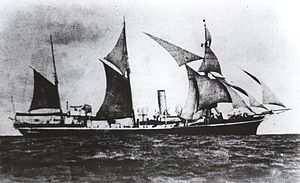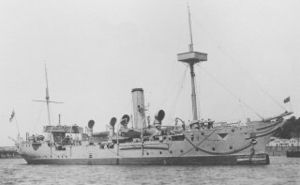- Condor class sloop
-


Shearwater under sail (top)
Rinaldo c. 1908 with sailing rig removed (bottom)Class overview Name: Condor-class sloops Builders: Sheerness Dockyard
William Laird & Son, BirkenheadOperators:  Royal Navy
Royal NavyBuilt: 1898-1900 In commission: 1898–1932 Completed: 6 Lost: 1 General characteristics Type: Screw steel sloop Displacement: 980 tons[1] Length: 204 ft (62 m) Beam: 32 ft 6 in (9.91 m) Draught: 11.5 ft (3.5 m) Installed power: 1,400 hp (1,044 kW)[2] Propulsion: - Four Belleville boilers
- Three-cylinder vertical triple expansion steam engine
- Twin screws[3]
Sail plan: Barque-rigged, changed to barquentine-rigged, later removed Endurance: 3,000 nmi (5,600 km) at 10 kn (19 km/h)[3] Complement: 130[1] Armament: Armour: Protective deck of 1 in (2.5 cm) to 1.5 in (3.8 cm) steel over machinery and boilers.[3] The Condor class was a six-ship class of 10-gun[3] screw steel sloops [1] built for the Royal Navy between 1898 and 1900. Condor foundered in a gale, prompting the Royal Navy to abandon sailing rigs for its ships. The last of the class, Mutine, survived until 1932 as a Royal Naval Volunteer Reserve drill ship.
Contents
Design
The Condor class was constructed of steel to a design by William White, the Royal Navy Director of Naval Construction.[3] They were powered by a three-cylinder vertical triple expansion steam engine developing 1,400 horsepower (1,000 kW) and driving twin screws.[3]
Sail plan
The class was originally designed and built with barque-rigged sails, although some pictures show ships of the class with a barquentine rig. Condor was lost in a gale during her first commission, and the contemporary gunnery pioneer Admiral Percy Scott ascribes her sinking to the encumbrance of sails, and furthermore believed that her loss finally convinced that Admiralty to abandon sails entirely.[4] All other ships of the class had their sails removed during the first few years of the twentieth century.
Armament
The class was armed with six 4-inch/25-pounder (1 ton) quick-firing breech loaders and four 3-pounder quick-firing breech loaders.[3]
Operational lives
The design of the Condor class differed from the screw sloops of the 1860s only in an evolutionary sense (although constructed of steel and armed with quick-loading guns, they retained the sails and layout of the earlier vessels); by the turn of the twentieth century they were thoroughly obsolete. The overseas stations of the Royal Navy were responsible for patrolling the maritime British Empire, and these ships were intended for that role. The rapidity with which they were converted to depot ships, training ships or survey ships gives testament to their outmoded design. According to Hansard, it was stated by the Secretary to the Admiralty about the almost identical Cadmus class in Parliament on 6 March 1905 that
“ they were never designed for fighting purposes but for subsidiary work in peace or war, for which they are still available, and in which they are at the present moment engaged. ” HMS Condor
Main article: HMS Condor (1898)During her short career, Condor served on the Pacific Station. On 3 December 1901 while on passage from Esquimalt to Hawaii she foundered in a gale off Vancouver Island (position approximately 48°15′N 125°40′W / 48.25°N 125.667°W). Her last contact was with the light station on Cape Flattery. All hands (130 ship's company and 10 supernumeries) were lost.[6] The tragedy occurred during her first commission and less than three years after her launch.[2] In May 1949 the trawler Blanco hauled up wreckage from a depth of 250 ft (76 m) The wreckage included a ship's binnacle matching that supplied to Condor.[7]
HMS Rosario
Main article: HMS Rosario (1898)Rosario relieved China Station in June 1900, and re-commissioned at Hong Kong on 5 November 1913, becoming a depot ship for submarines.[8] She was sold at Hong Kong in December 1921.
HMS Mutine
Main article: HMS Mutine (1900)While being delivered from Birkenhead to Portsmouth an accident in Mutine's boiler rooms caused some loss of life and gave her a name as an unlucky ship before her career even began.[9] She served on the China Station and became a survey ship, surviving until 1932 as an Royal Naval Volunteer Reserve drill ship, the last of her class to be sold.
HMS Rinaldo
Main article: HMS Rinaldo (1900)Rinaldo served in South-East Asia, including taking medical assistance to Brunei in August 1904 during an outbreak of smallpox.[10] By 1914 she was tender and training ship to Devonport Royal Naval Reserve.[11] She was sold for breaking in October 1921.
HMS Shearwater
Main article: HMS Shearwater (1900)Shearwater served on the Pacific Station. She recommissioned on 27 November 1912 at Esquimalt.[12] She was transferred to the Royal Canadian Navy as a submarine depot ship in 1915, sold to Western Shipping Co, Canada in May 1922 and renamed Vedas[3]
HMS Vestal
Main article: HMS Vestal (1900)Vestal served on the China Station, later becoming training ship and tender to HMS Excellent, Portsmouth.[13] She was sold for breaking on the same day as Rinaldo.
Ships
Name Ship Builder Launched Fate Sheerness Dockyard 17 December 1898 Foundered in a gale off Cape Flattery on 3 December 1901[2] Hong Kong in 1910. Sold there on 11 December 1921 [3] William Laird & Son, Birkenhead 1 March 1900 Survey ship 1907, RNVR drill ship 1925, sold to Ward, Briton Ferry on 16 August 1932[3] Anglesey on 21 October 1921[3] Shearwater Sheerness Dockyard 10 February 1900 Transferred to Royal Canadian Navy as submarine depot ship in 1915, sold to Western Shipping Co, Canada in May 1922 and renamed Vedas[3] edit] See also  Media related to Condor class sloop at Wikimedia Commons
Media related to Condor class sloop at Wikimedia CommonsReferences
- ^ a b c "Condor class at battleships-cruisers.co.uk". http://www.battleships-cruisers.co.uk/condor_class1.htm. Retrieved 2008-08-30.
- ^ a b c "HMS Condor at Naval Database website". http://www.pbenyon.plus.com/18-1900/C/01071.html. Retrieved 2008-09-06.
- ^ a b c d e f g h i j k l m n Winfield, Rif; Lyon, David (2004). The Sail and Steam Navy List: All the Ships of the Royal Navy 1815–1889. Chatham Publishing. ISBN 978-1-86176-032-6. OCLC 52620555.
- ^ Fifty Years in the Royal Navy, Admiral Sir Percy Scott, Bt., John Murray, London, 1919, p.37
- ^ "Hansard, 6 March 1905 vol 142 cc402-3, Questions in the House". http://hansard.millbanksystems.com/commons/1905/mar/06/hms-clio-and-cadmus. Retrieved 2008-09-07.
- ^ BBC Radio 4, Making Waves, 06 May 2003 (RealPlayer required)
- ^ "NOAA Olympic Coast National Marine Sanctuary website". http://olympiccoast.noaa.gov/living/history_and_culture/shipwrecks/condor.html. Retrieved 2008-09-06.
- ^ "HMS Rosario at Naval Database website". http://www.pbenyon.plus.com/18-1900/R/03988.html. Retrieved 2008-09-06.
- ^ "Condor class (additional page) at battleships-cruisers.co.uk". http://www.battleships-cruisers.co.uk/condor_class.htm. Retrieved 2008-09-06.
- ^ Colonial Office Correspondence Relating To Brunei 'Destroyed Under Statute' 1906–1934, by A V M Horton, IJAPS Vol. 1 2005
- ^ "HMS Rinaldo at Naval Database website". http://www.pbenyon.plus.com/18-1900/R/03947.html. Retrieved 2008-09-06.
- ^ "HMS Shearwater at Naval Database website". http://www.pbenyon.plus.com/18-1900/S/04243.html. Retrieved 2008-09-06.
- ^ "HMS Vestal at Naval Database website". http://www.pbenyon.plus.com/18-1900/U/05007.html. Retrieved 2008-09-06.
Condor-class sloop List of corvette and sloop classes of the Royal NavyCategories:- Sloop classes
- Condor class sloops
- Victorian era sloops of the United Kingdom
Wikimedia Foundation. 2010.
Look at other dictionaries:
Cadmus class sloop — The Cadmus class was a six ship class of 10 gun screw steel sloops cite web|url=http://www.battleships cruisers.co.uk/cadmus.htm|title= Cadmus class at battleships cruisers.co.uk|accessdate=2008 09 07] built for the Royal Navy between 1900 and… … Wikipedia
HMS Condor — Two vessels of the Royal Navy have been named HMS Condor after the condor, the largest flying land birds in the Western Hemisphere.* Condor , was a steam powered gunboat launched in 1876 and sold in 1889. She took part in the bombardment of… … Wikipedia
List of corvette and sloop classes of the Royal Navy — This is a list of corvette and sloop classes of the Royal Navy. The term corvette was not introduced into the Royal Navy until the 1830s, and at that time its use replaced both the larger sloops and also what had previously been categorised… … Wikipedia
HMS Fantome (1901) — HMS Fantome was an Cadmus class sloop launched in 1901, transferred to the Royal Australian Navy in 1914, returned to the Royal Navy in 1920 and sold in 1924. She was the fourth ship of the Royal Navy to bear the name, which is from the French… … Wikipedia
HMS Rosario — Seven ships of the Royal Navy have borne the name HMS Rosario , after the Spanish word Rosario , meaning rosary:*HMS Rosario was a hulk, previously the Spanish galleon Del Rosario . She was captured in 1588 and broken up in 1622. *HMS Rosario was … Wikipedia
Suez Crisis — The Tripartite Aggression The Sinai War Part of the Cold War and the Arab–Israeli conflict … Wikipedia
Bataille de l'Atlantique (1939-1945) — Pour les articles homonymes, voir Bataille de l Atlantique. Bataille de l Atlantique (1939 1945) Guetteurs sur un navire d escorte (octobre 1941) … Wikipédia en Français
C&C Yachts — was a Canadian based builder of high performance fiberglass monohull sloop rigged sailboats. It was founded in 1969 by a joint venture among several companies and design teams.History [The History of C C Yachts, By Dan Spurr; Good Old Boat… … Wikipedia
Ron Holland — (1947) is a yacht designer, who came to prominence in the 1970s with his successful racing designs, and is now best known for his superyachts such as Mirabella V, Ethereal. He is based in Kinsale, Ireland.Born in New Zealand, Holland was… … Wikipedia
List of disasters of the United Kingdom and preceding states — is a list of major disasters (excluding acts of war but including acts of terrorism) which relate to the United Kingdom since 1707, the states that preceded it (including territory that later became the Republic of Ireland), or involved UK… … Wikipedia

